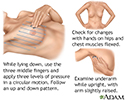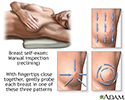Premenstrual breast changes
Premenstrual tenderness and swelling of the breasts; Breast tenderness - premenstrual; Breast swelling - premenstrual
Premenstrual swelling and tenderness of both breasts occurs during the second half of the menstrual cycle.
Considerations
Symptoms of premenstrual breast tenderness may range from mild to severe. Symptoms usually:
- Are most severe just before each menstrual period
- Improve during or right after the menstrual period
Breast tissue may have a dense, bumpy, "cobblestone" feel to the fingers. This feel is usually more in the outer areas. There may also be an off and on or ongoing sense of breast fullness with dull, heavy pain, and tenderness.
Causes
Hormone changes during the menstrual cycle likely lead to breast swelling. More estrogen is made early in the cycle and it peaks just before mid-cycle. This causes enlargement of the breast ducts.The amount of progesterone peaks near the 21st day (in a 28-day cycle). This causes growth of the breast lobules (milk glands).
Premenstrual breast swelling is often linked with:
-
Premenstrual syndrome
(PMS)
Premenstrual syndrome
Premenstrual syndrome (PMS) refers to a wide range of symptoms. The symptoms start during the second half of the menstrual cycle (14 or more days af...
 ImageRead Article Now Book Mark Article
ImageRead Article Now Book Mark Article -
Fibrocystic breast disease
(benign breast changes)
Fibrocystic breast disease
Fibrocystic breast disease is a common way to describe painful, lumpy breasts.
 ImageRead Article Now Book Mark Article
ImageRead Article Now Book Mark Article
Premenstrual breast tenderness and swelling probably occur to some degree in nearly all women. More severe symptoms may occur in many women during their childbearing years.The rate may be lower in women taking birth control pills.
Risk factors may include:
- Family history
- High-fat diet
- Too much caffeine
Home Care
Self-care tips:
- Eat a lower fat diet.
- Avoid caffeine (coffee, tea, and chocolate).
- Avoid salt 1 to 2 weeks before your period starts.
- Get vigorous exercise every day.
- Wear a well-fitting bra day and night to provide good breast support.
You should practice breast awareness. Do check your breasts for changes at regular intervals.
The effectiveness of vitamin E, vitamin B6, and herbal preparations such as evening primrose oil are somewhat controversial. This should be discussed with your health care provider.
When to Contact a Medical Professional
Call your provider if you:
- Have new, unusual, or changing lumps in breast tissue
- Have one-sided (unilateral) lumps in breast tissue
- Do not know how to properly perform breast self-examination
- Are a woman, age 40 or older, and have never had a screening mammogram
- Have discharge from your nipple, especially if it is a bloody or brown discharge
- Have symptoms that interfere with your ability to sleep, and diet changes and exercise have not helped
What to Expect at Your Office Visit
Your provider will take your medical history and do a physical examination. The provider will check for breast lumps , and will note the qualities of the lump (firm, soft, smooth, bumpy, and so on).
Breast lumps
A breast lump is swelling, a growth, or a lump in the breast. Breast lumps in both men and women raise concern for breast cancer, even though most l...

A mammogram or breast ultrasound may be done. These tests will evaluate any abnormal finding on a breast exam. If a lump is found that is not clearly benign , you may need a breast biopsy.
Mammogram
A mammogram is an x-ray picture of the breasts. It is used to find breast tumors and cancer.

Breast ultrasound
Breast ultrasound is a test that uses sound waves to examine the breasts.

Benign
"Benign" refers to a condition, tumor, or growth that is not cancerous. This means that it does not spread to other parts of the body. It does not ...

These medicines from your provider may reduce or eliminate symptoms:
- Injections or shots that contain the hormone progestin (Depoprovera). A single shot works for up to 90 days. These injections are given into the muscles of the upper arm or buttocks. They relieve symptoms by stopping menstrual periods.
- Birth control pills.
- Diuretics (water pills) taken before your menstrual period. These pills may reduce breast swelling and tenderness.
- Danazol may be used in severe cases. Danazol is a manmade androgen (male hormone). If this does not work for you, other medicines may be prescribed.
References
Alvero R. Premenstrual syndrome. In: Ferri FF, ed. Ferri's Clinical Advisor 2017 . Philadelphia, PA: Elsevier; 2017:1031-1032.
Jokich PM, Newell MS, Bailey L, et al; American College of Radiology. ACR appropriateness criteria, breast pain. Updated 2016. acsearch.acr.org/docs/3091546/Narrative/ . Accessed July 15, 2016.
Katz VL, Dotters D. Breast diseases: diagnosis and treatment of benign and malignant disease. In: Lentz GM, Lobo RA, Gershenson DM, Katz VL, eds. Comprehensive Gynecology . 6th ed. Philadelphia, PA: Elsevier Mosby; 2012:chap 15.
Lentz GM. Primary and secondary dysmenorrhea, premenstrual syndrome, and premenstrual dysphoric disorder: etiology, diagnosis, management. In: Lentz GM, Lobo RA, Gershenson DM, Katz VL, eds. Comprehensive Gynecology . 6th ed. Philadelphia, PA: Elsevier Mosby; 2012:chap 36.
The American College of Obstetricians and Gynecologists. Premenstrual syndrome (PMS). Updated January 2015. www.acog.org/Patients/FAQs/Dysmenorrhea-Painful-Periods . Accessed June 30, 2016.
-
Female Breast - illustration
The female breast is either of two mammary glands (organs of milk secretion) on the chest.
Female Breast
illustration
-
Breast self-exam - illustration
Monthly breast self-exams should always include: visual inspection (with and without a mirror) to note any changes in contour or texture; and manual inspection in standing and reclining positions to note any unusual lumps or thicknesses.
Breast self-exam
illustration
-
Breast self-exam - illustration
Monthly breast self-exams should always include: visual inspection (with and without a mirror) to note any changes in contour or texture; and manual inspection in standing and reclining positions to note any unusual lumps or thicknesses.
Breast self-exam
illustration
-
Breast self-exam - illustration
Monthly breast self-exams should always include: visual inspection (with and without a mirror) to note any changes in contour or texture; and manual inspection in standing and reclining positions to note any unusual lumps or thicknesses.
Breast self-exam
illustration
-
Female Breast - illustration
The female breast is either of two mammary glands (organs of milk secretion) on the chest.
Female Breast
illustration
-
Breast self-exam - illustration
Monthly breast self-exams should always include: visual inspection (with and without a mirror) to note any changes in contour or texture; and manual inspection in standing and reclining positions to note any unusual lumps or thicknesses.
Breast self-exam
illustration
-
Breast self-exam - illustration
Monthly breast self-exams should always include: visual inspection (with and without a mirror) to note any changes in contour or texture; and manual inspection in standing and reclining positions to note any unusual lumps or thicknesses.
Breast self-exam
illustration
-
Breast self-exam - illustration
Monthly breast self-exams should always include: visual inspection (with and without a mirror) to note any changes in contour or texture; and manual inspection in standing and reclining positions to note any unusual lumps or thicknesses.
Breast self-exam
illustration
Review Date: 5/21/2016
Reviewed By: Linda J. Vorvick, MD, Medical Director and Director of Didactic Curriculum, MEDEX Northwest Division of Physician Assistant Studies, Department of Family Medicine, UW Medicine, School of Medicine, University of Washington, Seattle, WA. Also reviewed by David Zieve, MD, MHA, Isla Ogilvie, PhD, and the A.D.A.M. Editorial team.




